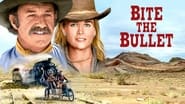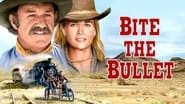Ross622
There are many great westerns that I have had the pleasure to see over the past several years that are in the elite pantheon of true western classics and this one makes that list with ease though it doesn't really have the story-line of the traditional western movie. The movie is set in 1906 in the southwestern part of the United States where people are competing in a 700 mile horse race and whoever wins gets $ 2,500 and survives. Gene Hackman stars as Sam Clayton a man who served in President Theodore Roosevelt's select regiment known as the "Rough Riders" during the Spanish-American War, and charged up San Juan Hill alongside him, his competitors include a woman named Miss Jones (Candice Bergen), a fellow rough rider turned gambler named Luke Matthews (James Coburn), a young kid (Jan-Michael Vincent), and an old man nicknamed "Mister" (Ben Johnson) who doesn't survive the whole ride. It is worth noting that until I watched this movie I hadn't seen a horse racing movie in the form of a western, and not only does the excellent performances from Hackman, Bergen, and Coburn, as well as the excellent script and direction from Richard Brooks qualify it to be one of the best westerns that I have ever seen it is also the best movie about horse racing that I have seen since "Seabiscuit" (2003). The cinematography by Harry Stradling Jr. is beautiful to see with all of the excellent desert shots which were so good that it made me think of many of the old westerns that were directed by the great John Ford. Also with this movie Brooks does an excellent job of letting us get to know each of the characters with really good dialogue for each respective character so that we can share sympathy and empathy for the conditions that they have to deal with while racing every single day, and the set design along with the costumes being expertly designed. This is a movie that is entirely memorable because of the entertainment and everything else that I previously mentioned, but one thing that I didn't mention was the score by the great Alex North which heightens the suspense during the racing scenes in the movie. It is a truly great movie that should be appreciated more than it currently is right now.
thefinalcredits
'Don't you know Sam Clayton? Defender of dumb animals, damsels in distress. Champion of lost causes.'Potentially, this project held out the promise of writer/director, Richard Brooks, adding to the list of critical successes from earlier in his career. This was especially the case as his last venture into the western, the 'Professionals', nine years earlier, was acclaimed as having revitalised the genre, earning him Academy Award nominations as both director and writer. Yet, the main flaw of this feature is in the weak structure of the overall narrative - an area in which Brooks would normally excel. This is surprising, given the rich vein of material he was exploring. Based on the real-life 700 mile endurance race organised by the 'Denver Post' newspaper in 1908, the story-line held out great promise, but suffers in various respects. The first of these concerns a common pitfall of ensemble casts in that by attempting to flesh out each character in turn, the risk is run that none is fleshed out sufficiently. This is even true of Gene Hackman's central protagonist, former 'Rough Rider' and animal lover, Sam Clayton. The second allied weakness of this feature comprises the lack of logical character arcs. As such, some protagonists undergo completely inexplicable emotional or psychological changes. An illustration of this is how the young, headstrong wannabe, played capably by Jan-Michael Vincent in one of his rare better performances, suddenly becomes a willing gofer for Clayton and his friends. Yet, this is nothing compared to the transformation undertaken by Hackman's lead character. The opening scenes clearly establish how Clayton abhors unnecessary suffering to animals. Moreover, despite being hired to ensure the champion steed backed by the newspaper tycoons reaches the starting line, he questions the integrity of a race where a winning horse endures far more physical hardship but the rider takes all the glory. Therefore, his decision to not just take part but to drive his own horse to the point of being dead on its feet - an act for which he had earlier handed out a brutal thrashing to Vincent's character - defies any logic. A third flaw with the plot is the clumsy incorporation of the sub-plot centred on Candice Bergen's character's hidden motive for participating in the race. Not only does this lead to an incongruous, almost comical, motorbike versus equine chase, but her culpability in events nearly costing the life of a fellow participant is treated with complete disinterest. Finally, the race itself appears disjointed with the finale tacked on without any real build-up of tension. In terms of the acting, Hackman gives a creditable performance with what little he is given in a genre which would not serve him well till his collaboration with Eastwood in the early nineties. In addition, both James Coburn, as Clayton's gambling former Rough Rider companion, and Ian Bannon, as the competing English aristocrat, ably support, though their characters remain one-dimensional. Yet, stealing the show in a supporting role, which should have earned an Academy Award nomination, is Ben Johnson as the anonymous 'Mister', a veteran 'Jack-of-all-trades' seeking to make a name for himself before he dies. If the poor continuity of the film reflects badly on the writer-director, Brooks does show glimpses of his talent with some well-crafted dialogue. Perhaps, best of these centres on Clayton's honest account of serving in the Rough Riders in Cuba alongside Teddy Roosevelt: 'We didn't charge up there...We crawled up there on our scared bellies.' Another saving grace for the feature is the splendid cinematography of Harry Stradling Jr, which so brilliantly captures the majestic landscape of New Mexico. By contrast, the upbeat soundtrack by Alex North is out of harmony with the general tenor of the film, and way too standard fare for a Western to be singled out for an Oscar nomination as it was. Overall, a muddled project, which even when experimenting. such as with the use of 'slow-mo', lacks any cohesive rationale or plot.
SnoopyStyle
It's early 20th century. Various riders answer the call to compete in a 700 mile race. It stars Gene Hackman, Candice Bergen, James Coburn, Ben Johnson, Jan-Machael Vincent among others.This is a good functional road movie. There are various archetype characters. Their competition and comradery are treated with realism. The camera work in the desert is good with the exception of one slow-motion scene which obviously doesn't work. The twist near the end is great and fitting. There's just enough foreshadowing to create a good sense of satisfaction. However, the consequences of the twist was treated much too lightly. The music, and the way the chase was conducted was too silly and ill fitting.
winner55
I saw this when it first came out and thoroughly enjoyed myself. Viewed again recently on disc, I can now see the flaws that kept this film off lists of "classic Westerns." The most obvious moment of misjudgment comes in the big chase scene at the end. It's totally misplaced, and probably was intended for the middle of the picture, then delayed to provide more screen time for the female lead. It does not lead well into the finale, and now stands as one of the worst continuity lapses of all time. Worse, there seems to be some sequence that got lost in order for this scene to be placed where it is. At any rate, the ending is mystifying in small details, but enough to leave one feeling oddly unsatisfied.Others have noted the second-rate editing throughout the film; but continuity errors of this sort are the director's responsibility. One feels that the director realized that he had bit off more than he could chew, and rather than put it back on the plate to chop it up into smaller, more manageable pieces, let it sort of drool out between his lips hoping no one would notice.And this story would have worked on a lower budget, with a shorter run time, made in the late 1950s. Admittedly the photography is grand, and there are marvelous set-pieces throughout - but they don't add up to the great Western this story could have been.





